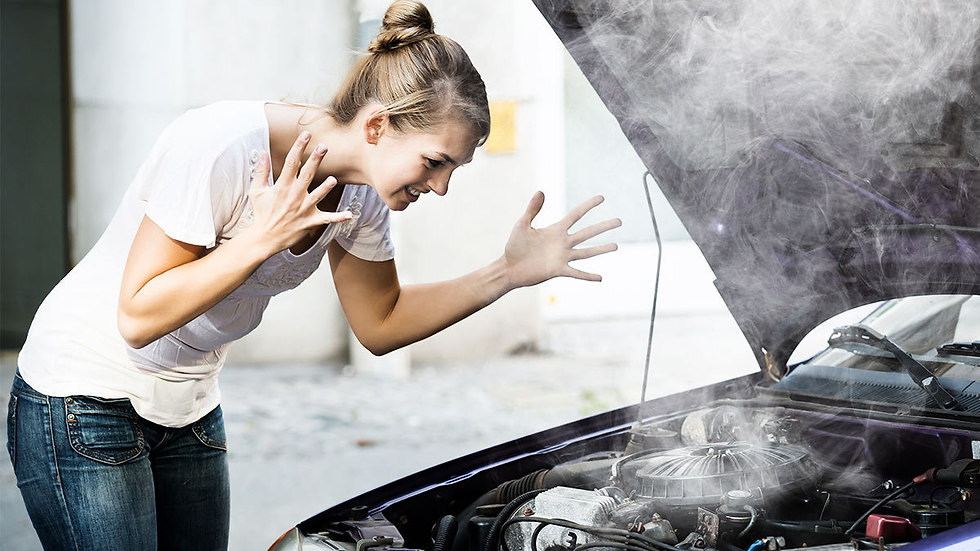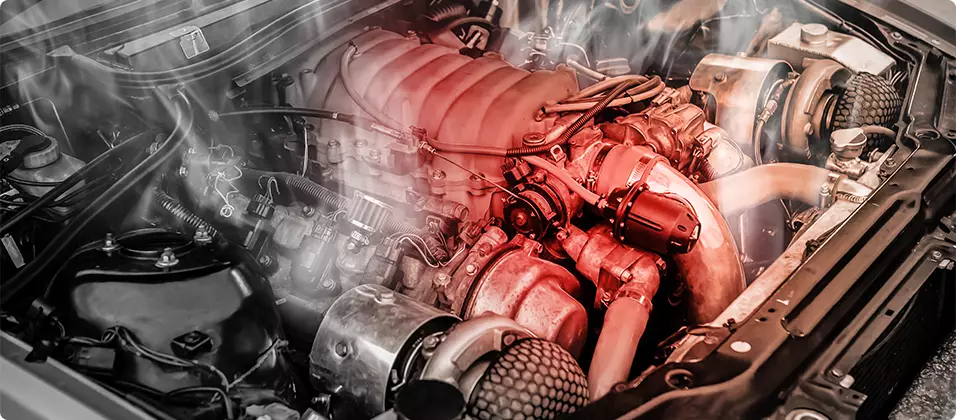Engine Overheating: Causes and Prevention
- Quality Auto & Body

- 18 jul 2024
- 4 Min. de lectura
Engine overheating is one of the most serious mechanical issues that can affect a vehicle. When an engine overheats, it can cause significant damage, leading to costly repairs and potential safety hazards for the driver. Understanding the causes of engine overheating and how to prevent it is crucial for maintaining vehicle performance. This guide provides a detailed overview of the causes of engine overheating and preventive measures to avoid this issue.
1. Causes of Engine Overheating
A. Leaks in the Cooling System
One of the most common causes of engine overheating is a leak in the cooling system. The engine's cooling system is designed to maintain the engine temperature within a safe range. Leaks can occur in various parts of the system, including the radiator, hoses, water pump, and thermostat. When there is a leak, coolant can be lost, reducing the system’s ability to cool the engine effectively.
B. Water Pump Failure
The water pump is responsible for circulating coolant through the engine and radiator. If the water pump fails, coolant will not circulate properly, which can lead to engine overheating. Symptoms of a faulty water pump include unusual noises, coolant loss, and an increase in engine temperature.
C. Faulty Thermostat
The thermostat controls the flow of coolant in the engine. If the thermostat is stuck in the closed position, coolant cannot flow to the radiator to be cooled, causing the engine to overheat. A faulty thermostat can be identified by the engine temperature remaining high even after prolonged running.
D. Blocked Radiator
The radiator plays a crucial role in the cooling system. Its function is to dissipate heat from the coolant before it returns to the engine. If the radiator is blocked with dirt, debris, or rust deposits, it cannot cool the coolant effectively, which can lead to engine overheating.
E. Radiator Fan Issues
The radiator fan helps cool the coolant when the vehicle is stopped or moving slowly. If the fan is not working properly, the radiator may not cool effectively, causing an increase in engine temperature. Issues with the fan can be caused by a faulty fan motor, defective temperature switches, or electrical problems.
F. Coolant Problems
Coolant, also known as antifreeze, is essential for maintaining engine temperature. If the coolant is low or contaminated, it cannot perform its cooling function effectively. Coolant levels should be checked and replaced regularly to ensure its effectiveness.
G. Head Gasket Problems
The head gasket seals the top of the engine and allows coolant to circulate through the engine without leaks. If the head gasket fails, coolant can leak into the engine cylinders, causing overheating. Symptoms of a faulty head gasket include white smoke from the exhaust, loss of engine power, and a mix of oil and coolant.
2. Symptoms of Engine Overheating
A. High Temperature Gauge
One of the first signs of overheating is the temperature gauge on the dashboard. If the temperature gauge is in the red zone or higher than normal, it is a clear indication that the engine is overheating.
B. Engine Alert Light
Many vehicles are equipped with an alert light that turns on if the engine is overheating. If you see this light illuminated, it is important to stop the vehicle as soon as possible and check the cooling system.
C. Steam from the Radiator
If you see steam coming from the radiator or under the hood, it may indicate that the engine is overheating. Steam can be caused by excessive pressure in the cooling system due to a leak or radiator failure.
D. Unusual Noises
Unusual noises such as knocking or buzzing from the engine can be an indication of overheating. These noises can be caused by metal expanding due to excessive heat.
3. Preventive Measures to Avoid Engine Overheating
A. Regular Cooling System Maintenance
Performing regular maintenance on the cooling system is crucial to prevent engine overheating. This includes checking and replacing coolant regularly, inspecting hoses and connections, and cleaning the radiator.
B. Water Pump Inspection
Periodically check the water pump to ensure it is functioning correctly. If leaks or unusual noises are detected, replace the water pump immediately.
C. Thermostat Replacement
The thermostat should be inspected and replaced if necessary. If you experience issues with engine temperature, consider replacing the thermostat as part of the diagnosis.
D. Radiator Cleaning
Regularly clean the radiator to prevent the buildup of debris and rust that can obstruct airflow. Cleaning the radiator can improve the efficiency of the cooling system.
E. Radiator Fan Check
Ensure that the radiator fan is working correctly. Perform periodic tests to verify that the fan turns on when the engine reaches high temperatures.

F. Coolant Level and Quality Check
Regularly check the level and quality of the coolant. Ensure that the coolant is at the proper level and is not contaminated.
G. Head Gasket Inspection
Although less frequent, the head gasket should be inspected if engine problems are suspected. Replace the gasket if there are signs of leaks or damage.
4. What to Do in Case of Overheating
A. Stop the Vehicle
If you notice signs of overheating, stop the vehicle as soon as possible in a safe location. Turn off the engine and wait for it to cool down before opening the hood.
B. Inspect the Cooling System
Once the engine has cooled, inspect the cooling system for possible leaks or problems. Ensure that the coolant level is adequate.
C. Contact a Professional
If overheating persists or you cannot identify the cause, contact a professional mechanic to perform an inspection and proper repair of the cooling system.
Conclusion
Engine overheating is a serious issue that can have severe consequences for vehicle health. Understanding common causes and following appropriate preventive measures can help avoid this problem and ensure proper engine function. Regular maintenance and being attentive to overheating symptoms are key steps in keeping the engine in optimal condition and avoiding costly repairs.











Comentarios